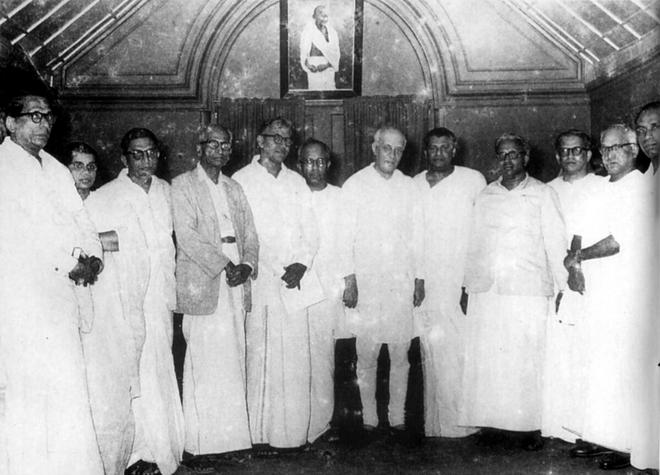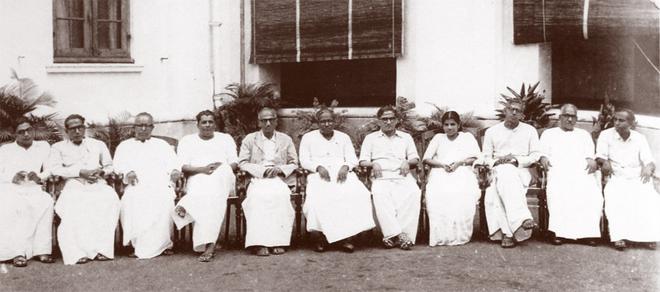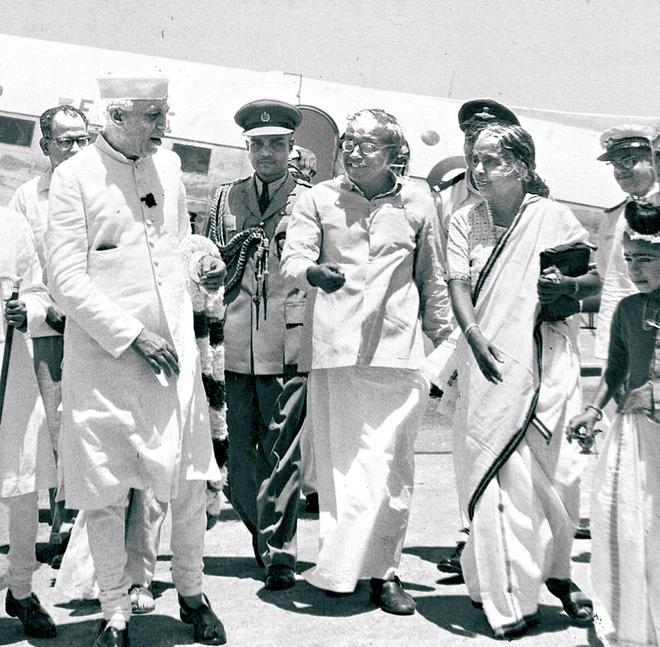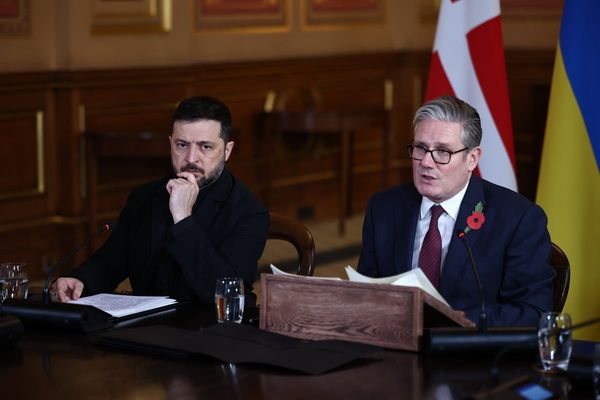The year 1957 was a significant one for India. The Indian National Congress (INC) retained control and returned to power for a second consecutive term at the Centre. Meanwhile, the Communist Party of India (CPI) created history by winning the Assembly election in Kerala, forming India’s first democratically elected communist government and setting a precedent for parliamentary communism, which remains a unique feature of Indian democracy.
The backstory of Kerala
Before Independence, the State of Kerala as we know it today was a collection of princely states and British administered provinces; the northern regions, including Dakshina Kannada (South Canara) and the Malabar district were a part of the Madras Presidency, and the southern regions were either a part of the Kingdom of Cochin or the bigger Kingdom of Travancore. The Congress party was the dominant political force in the region, while communism didn’t gain much ground until the 1930s, when there was a significant social upheaval in the State.
During this period, the traditional social order was being challenged, and the matrilineal system was gradually collapsing. People were becoming more aware of caste divisions, leading to an increase in class consciousness among the poor. Additionally, there were religious and gender reforms that paved the way for struggles for social justice and economic equality. Researcher-writer Robin Jeffrey explains, “…orthodox notions of caste, which enforced extreme disabilities against low castes were increasingly undermined by Western-style education and new economic opportunities. Traditional values appeared increasingly absurd to an ever larger number of people.”
“Marxism in Kerala came to fill the ideological gap keenly felt by thousands of literate, alienated people. Given glaring class divisions, high rates of literacy and heavy population density, what was crucial in directing Malayalis towards communism was the breakdown of the social system,” he writes.
On the road to communism
The roots of communism in Kerala go back to socialist tendencies within the Congress during India’s freedom struggle. When Mahatma Gandhi announced the Salt Satyagraha March of 1930 (also known as the Dandi March), a small group led by Congress leader , K. Kelappan Nair, set out from Kozhikode to make salt in Payyannur, located in Kannur district. At the time, the party had a strong hold on the youth in Kerala. As per contemporary accounts, the civil disobedience movement flashed like an “electric current,” resulting in the arrest of hundreds of people.
Several KPCC leaders, including E.M.S. Namboodiripad, who was already involved in social reform movements, joined the agitation as it picked up pace in 1932. By the end, over a thousand Malayalis were arrested. They spent a considerable amount of time in jail, during which they were exposed to Marxist literature. Some even used this time to translate communist texts into Malayalam.
Most of the jailed Congress leaders were released between 1933 and 1934. As they walked free, some felt that Gandhian methods had failed to achieve social revolution and freedom in the country. This led to ideological differences and, eventually, factionalism that threatened the party’s unity.
Amid growing disillusionment, a few KPCC leaders set up a local branch of the Congress Socialist Party (CSP) in 1934; the CSP had been set up a few months before by Jayaprakash Narayan. They aimed to link the struggle for national freedom with social revolution. Later, communists emerged in Kerala as a direct outgrowth of this left-wing faction.
Within a short span, thousands enrolled in the KCSP. Socialists became an important force within the Kerala chapter of the Congress. They worked with peasants, the working class and small landowners, and led mass movements against feudalism and caste discrimination in Travancore, Cochin and Malabar, thereby establishing a strong presence in the region.
In 1937, P. Krishna Pillai, K. Damodaran, N.C. Sekhar and E.M.S. Namboodripad secretly joined the Communist Party of India. In E.M.S.’ words, almost the entire CSP in Kerala had decided to join the CPI towards the end of 1939 and start of 1940.
This lead to concerns over attempts to capture the Congress.
E.M.S., however, rejected the theory later in an interview in Frontline. “I was transformed from an ordinary Congressman into a Congress Socialist and from a Congress Socialist into a communist through the sheer process of my practical experience and discussions. Nobody would have been able to capture me, nor would I have been able to capture anybody else. After all, it was a period in which intense discussions and intense searching of the minds, were going on among all of us. As a result of that some ideology got the upper hand, some ideology went behind…This idea of somebody having some sinister plan to capture that organisation is absurd. People were changing. They had their own independent thinking,” he said.
Journalist R. Krishnakumar threw light on this transformative period in another article,“The period [between 1934 and 1939] saw the sprouting of independent class organisations of peasants and workers and those representing teachers, students, youth and women, and the launching of organised struggles against capitalism and the landed gentry. The unity of the working class assumed a new meaning in Kerala and its leaders could successfully link all these struggles to their cause and the freedom movement.”
Communists finally came out of the shadows of the Congress when the Second World War broke out in 1939. During a conference of the CSP in Tellicherry (now Thalassery), around 100 members of the Kerala unit of the Congress Socialists joined the Communist Party of India.
This latest entrant to Kerala politics took upon itself the task of liberating peasants and workers from their caste-based and feudalistic socio-economic thraldom. “Under its leadership, social movements with land rights as their core demand became mass-based and protracted. More importantly, the party strategically turned the struggles of tenants for land rights into struggles of tenants, the landless and the land poor for land ownership rights,” notes sociology professor P. Radhakrishnan.
Researcher S. Harikrishnan argues in his paper on communism and social spaces that communists managed to create a strong network of social spaces by the mid-20th century which constituted “informal but vibrant associational spaces for the youngsters, predominantly male.”
“In the second half of the 20th century, Communist party-led trade unions, arts and cultural associations, and literary and science forums all inundated the public sphere, taking communism to the common masses through theatre, music, pamphlets, lectures and stories,” Mr. Harikrishnan adds.
Communists also built on an all-Kerala agenda and led an agitation of Malayalam speakers for linguistic reorganisation, called Aikya Keralam (unified Kerala).
In 1947, India gained independence from British rule. Malabar became an Indian district, while Travancore and Cochin merged with the Union in 1949. In March 1956, the Congress ministry in Travancore-Cochin resigned after the defection of six members of the Congress Legislature Party, following which President’s rule was imposed.
The merger
After almost a decade of short-lived governments, it was during President’s rule that the three regions were merged to form the State of Kerala. Travancore-Cochin was merged with the Malabar district of Madras and Kasaragod taluk of South Canara district. Under the States Reorganisation Act, 1956, the southern part of Thiru-Kochi which included the Kanyakumari district was transferred to Madras State (which eventually became Tamil Nadu.) The merger bolstered the communists’ electoral base in Kerala. The Congress party, meanwhile, fought factionalism.
As part of the next step to restore normal constitutional government in the State, Assembly elections were announced from February 28 to March 11, 1957. A total of 406 contenders were in the fray for 126 Assembly seats, which included 12 two-member constituencies. The CPI contested 100 seats. .
The Rise of Red Kerala
The results of this first Assembly election in Kerala after linguistic reorganisation made headlines across the globe. Winning 60 out of 126 seats , the undivided CPI went on to form the government with the support of five Independents. With a historic victory, the party became one of the first democratically elected communist governments in the world. An earlier instance, however, could be traced back to 1945, when the Communist Party, as part of a coalition with the Socialist Party, had won an election and formed the government in the Republic of San Marino.

The world watched as E. M. S. Namboodiripad took oath on April 5, 1957 as the first Chief Minister of the “problem State.” The U.S. expressed apprehension over the concentration of political power in the hands of communists. PM Jawaharlal Nehru, meanwhile, expressed willingness to give communists a chance.
Mr. Nehru was also reassured by the new CM’s promise that his Cabinet would work within the framework of the Constitution and not “seek to establish a Communist society” in Kerala. The government further promised to promote industrial peace and introduce land reforms.

Decoding electoral victory
The rise of communists was viewed as the culmination of the various movements of the working class and the peasantry that the CPI members had led alongside the freedom struggle. The instability in the Congress, or lack of a better alternative. was another contributing factor.
An editorial in The Hindu (dated March 22, 1957) pointed out that one of the factors that pushed the electorate to vote for communists was the “desire to see that a situation similar to what had resulted after the two previous elections in which no single party was returned in sufficient strength to constitute a stable government, did not recur.”
It also noted that the victory couldn’t be regarded as an unequivocal vote for communism since the votes polled by Congress were more than that of the CPI. “The Communist party’s propaganda has been emphasising such generalities as agrarian reform, removal of unemployment, elimination of corruption, etc. rather than any definite blueprint for action in which the party’s ideology might be more sharply visible,” it said.

The significance
And so, communists won the election fairly and democratically, offering people an alternative to Congress. “Although not powerful enough to replace the Congress at the Centre, the party was strong enough in one State to show that land reforms, educational reforms, the decentralisation of power to panchayats and so on — formal objectives of the Congress that were later sabotaged — could be implemented by a non-Congress government headed by the Communist Party,” E.M.S told Frontline later.
“Together with the socialists and Left democrats, the Communists succeeded in slowly developing democratic movements that could challenge the authority of the Congress Government at the Centre. That process ultimately led to the formation of another Left-led Government, in West Bengal, together with non-Left-led non-Congress governments in half a dozen other States,” he said.
In his book Communism in India, Bidyut Chakrabarty, an expert on contemporary Indian political economy and social movements, did a similar analysis. “Though short-lived, the communist rule in Kerala projected an alternative form of governance that could be utilised for radical socio-economic changes within liberal democracy. So, with the formation of Namboodiripad’s ministry in 1957, the parliamentary left was no longer a conceptual category but became a form of governance with its theoretical roots in Edward Bernstein’s conceptualisation of Marxism–Leninism-driven social democracy,” Mr. Chakrabarty wrote.
In the following years, the Left gained influence in national politics and consolidated its strength in West Bengal and Tripura. “The CPM’s commitment to Leninism, democratic centralism, and revolutionary transition, while de facto pursuing social democratic reforms, make for occasionally fraught relations with India’s social movements. Yet communism and Marxism remain powerful reference points for Indian intellectuals and popular movements to a greater extent than in any other parliamentary democracy,” highlights Hans Lofgren in an article in the Arena magazine.
The author further suggests that the Left brought the vast majority of people into the democratic process in the country. “Where the Left has held State government, particularly in Kerala, democracy has gained more substance in terms of genuine local government, better education and health services, a more vibrant civil society, and generally better protection for workers and peasants than in other states,” he adds.
The Devikulam bypoll
The communists registered another tremendous victory in the Devikulam bypoll of 1958 that saw a high-stakes clash between Rosamma Punnoose from the CPI and Congress’ B.K. Nair. Indira Gandhi herself came to Devikulam to campaign for her colleague. AIADMK leader M.G. Ramachandran (MGR), meanwhile, campaigned for Rosamma.
The Communist leader won by 7,000 votes, leaving the Congress high command in Delhi shocked. The editorial in The Hindu described Rosamma’s victory as “a vote against the Congress organisation.”
“The people in Kerala — where, whatever the professed ideals of Communism, the administration has shown itself alive to public opinion — could hardly be expected to enthuse themselves over Congress election slogans,” it said.
The Times of India said (in an article dated May 26, 1958) that the Devikulam bypoll shattered the morale of all opposition parties in Kerala. “The Congress alone is not the sufferer,” it remarked.
The dismissal
Within days of coming to power, the Namboodiripad-led government gave shape to its reform agenda. Within a week, the government issued an ordinance (and later legislation) that fixed a ceiling on the amount of land a family could own. The legislation banned the eviction of tenant farmers, fixed fair rent and gave tenants the right to purchase the land they were cultivating.
Former SC Judge V.R. Krishna Iyer, who served as a Minister in 1957 government, wrote in his tribute to the former CM, “He insisted that land reforms, which was the nation’s pledge on gaining Independence, would be implemented without delay, that peasants would not be evicted by latifundists (large landowners) with clout, that labour would be assured of a fair deal and that the police would not interfere in peasant struggles and labour strikes on the side of the landlords and industrial magnates. Social justice in many dimensions would be accomplished for the people and promotion of agriculture and industry would be given high priority. People’s participation would be a policy imperative.”
The government also brought in educational reforms, which rattled existing stakeholders like the Catholic Church, the Nair Service Society (NSS) and the Indian Union Muslim League. They were up in arms against the communist government. The Congress seized the opportunity and launched Vimochana Samaram (Liberation Struggle) campaign. Protests and strikes followed. The agitation turned violent and the Congress expressed concern over the “deteriorating” law and order in the State.
Mr. Iyer said it was the Congress party that gave leadership to this movement of “chaos and anarchy.” He further recounted, “Namboodiripad requested me to apprise Nehru of the shocking developments, organised by the vested interests of Kerala and abetted aggressively by the Congress party. Many within the Congress, like V. K. Krishna Menon, did not agree with this unconstitutional programme of action. Under the direction of E.M.S, I met Nehru at Ooty and explained to him that under the hegemony of his party (of which Indira Gandhi was then president) the Church, the NSS and other reactionary forces were conspiring to tear up the Constitution of India and the Kerala regime which implemented the great promises of its Preamble. Nehru seemed stunned and asked ‘Indu’ to discuss the matter with me. That formality was a ritual and Nehru’s condemnation was formal.”
The death of a pregnant fisherwoman in a subsequent police firing aggravated the situation. Her death became the symbol of the anti-communist movement.
The Liberation Struggle ultimately resulted in the dismissal of the first communist State government. On July 31, 1959, President Dr Rajendra Prasad invoked Article 356 on the advice of the Jawaharlal Nehru-led Cabinet and dissolved the Kerala Assembly.
Reacting to the development, the communist newspaper New Age wrote history would never forgive Prime Minister Jawaharlal Nehru. E.M.S, meanwhile, remarked, “Everything looks yellow to a jaundiced eye”.
He refused to bow down. The communists and E.M.S. eventually returned for a second stint in power in 1967.







